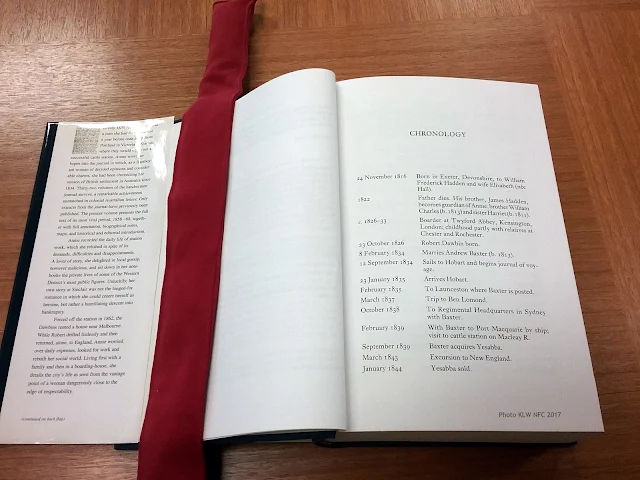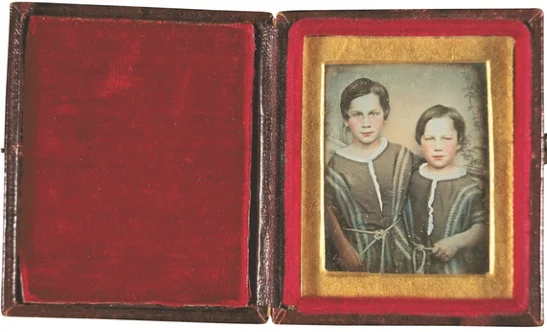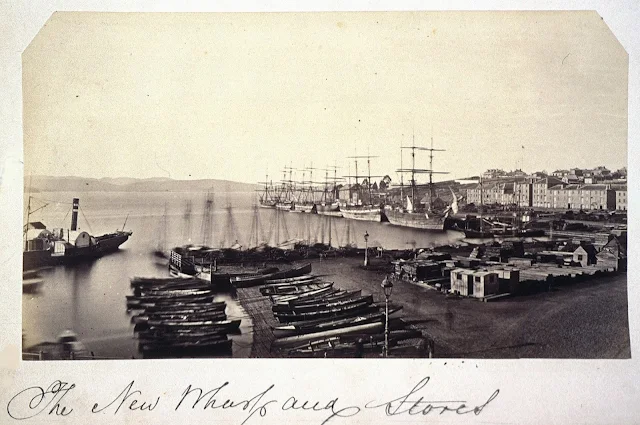ACCLIMATISATION SOCIETIES salmon trout ova
BUDDEN PHOTO COLLECTIONS
Here is a stereograph attributed to Tasmanian photographer Samuel Clifford ca. 1868 which was cleanly mounted in a binocular frame. The examples below, in relation to Stephen Budden's visit to Tasmania in 1873, were not so fortunate to survive in such original condition. They were printed first as slides from the glass plate negative, using black circular or rectangular masks, and were subsequently printed from the slide onto a stereographic mount, leaving the blackened edges of the mask visible.

Salmon Ponds, nr. New Norfolk
Author: Clifford, Samuel, 1827-1890.
Publication Information: 1868.
Physical description: 1 stereoscopic pair of photographs : sepia toned ; each 7 cm. in diam.
Notes:Circular imagess
Archives Office Tasmania
https://stors.tas.gov.au/AUTAS001136194172
Stephen Budden, commercial agent from Lyttleton, New Zealand for the Canterbury Acclimatisation Society arrived at New Wharf, Hobart, Tasmania, on 4th August 1873, the sole passenger aboard the brig Chanticleer under command of Capt. G. A. Phillips. His mission was to superintend a shipment of salmon and salmon trout ova back to New Zealand. With assistance from the Tasmanian Acclimatisation Society and naturalist and amateur photographer, Morton Allport, who was instrumental in the introduction of salmon ova and European fish to Tasmania in the 1860s, two shipments were sent: the first of salmon trout ova was accompanied by Stephen Budden on the Clematis, departing 29th August; and the second of 500 brown trout ova destined for the Auckland Climatisation Society left on the Bella Mary on the 23rd August 1873. As a result of Stephen Budden's successful mission, Morton Allport was made an honorary life member of the Otago Acclimatisation Society.
NEWSPAPER NOTICES
The first Mercury report of Stephen Budden's arrival in Hobart assumed he was an official of the New Zealand Government. On reading it, he penned a letter to the editor, requesting correction.
Stephen Budden arrives in Hobart, mistakenly reported as a NZ Gov't official
Source: The Mercury, 4th August 1873
TRANSCRIPT
The brig Chanticleer, Captain G. A. Phillips, from Lyttleton, New Zealand, in ballast, came into port on Saturday afternoon.... She has one passenger, a Mr Budden, who has come up on the part of the New Zealand Government to superintend the shipment of trout and salmon trout ova to New Zealand.Stephen Budden may have taken this photograph of rocks, perhaps because the rocks were being unloaded as ballast from the brig Chanticleer at New Wharf, or because those rocks were destined for Dr. Julius Haarst, NZ Government Geologist and Naturalist. The original photograph might have been taken by Stephen Budden's counterpart, Morton Allport. Although attributed to Samuel Clifford (at Douglas Stewart Fine Books), the reprint from the lantern slide showing the black circular mask in a square mount is unlikely to be the final commercial product offered to tourists by Samuel Clifford, or indeed his partner Thomas Nevin in the 1870s:



Douglas Stewart Fine Books
Hobart Town from the Wharf
CLIFFORD, Samuel (1827-1890) (attributed) # 12743
[Title from contemporary inscription verso]. 1861-1865. Stereoscopic albumen print photograph, each image approximately 80 x 80 mm, on pale yellow card mount; a 15 mm tear at upper edge, otherwise the albumen prints are in good condition.
Round and square black border masks used for producing magic lantern slides
Source: eBay and The Magic Lantern Society (UK)
Quite a few of these rather unappealing amateur reprints have appeared in the market place in recent times. Most were transcribed in a contemporary hand with general information about the place of capture, eg. a building or scenic view, but with the word "Tasmania" included, simply because the collector was an intercolonial visitor who needed a reminder of the photograph's subject. Some have a note written verso stating what the building or streetscape looked like "30 years ago", eg. St. David's Church in Macquarie Street, dating the print from its original photograph ca. 1870 to ca. 1890. Who was responsible for reprinting these stereographs from the slides with black masks onto a yellow square card, or why they were reprinted in this manner, is not known, but Stephen Budden's brother Frank Budden, was resident of London in the 1880s, and his son's name - T. F. Budden - stamped on the versos of some of these reprints, suggests that the Budden family may be the source of the reprints. Dr Tice Frank Budden became a renowned photographer of trains in Britain in the 1890s.

Nephew of Stephen Budden, T. F. Budden blue stamp and
Budden also pencilled along right-hand side
Verso of a stereograph taken at Fern Tree Gully Tasmania (eBay item 2016)
Several of these stamped verso taken at the Chudleigh Caves, Tasmania were also on eBay2010
Stephen Budden's letter to the editor requesting correction
Source: The Mercury 5th August 1873
TRANSCRIPT
AN EXPLANATIONTwo shipments were sent: one of salmon trout ova was accompanied by Stephen Budden on the Clematis, departing 29th August; and the second of 500 brown trout ova destined for the Auckland Climatisation Society left on the Bella Mary the 23rd August 1873.
TO THE EDITOR OF THE MERCURY
SIR, - I shall feel obliged if you will correct an inaccuracy which occurs in the shipping report of this morning's issue of your paper, with reference to my name It is stated that I have come on behalf of the New Zealand Government, for the salmon trout ova. This is not the case. It is on behalf of the Canterbury Acclimatisation Society that I have come. Your insertion of the above will
Oblige yours, &c.,
STEPHEN BUDDEN.
Hobart Town
4th August, 1873
Stephen Budden returns to NZ with salmon trout ova
Source: The Mercury 29th August 1873
TRANSCRIPT
The brig Clematis, Capt. Johnson, entered and cleared out yesterday for Lyttleton with a full cargo of timber, hops, and bark. She also takes down some Salmon Trout Ova under the charge of S. Budden Esq., for the Canterbury Acclimatisation Society. The Clematis will sail early this morning.Trout Hatching at the Museum
Stephen Budden spent 25 days in Tasmania. He travelled around and across the island with a group attached to public institutions, whom he thanked in this article. published in the Mercury, 6th September 1873. His collection of photographs, probably sourced from Morton Allport, included scenes taken at Port Arthur, at Grass Tree Hill, Richmond, at Cascades, South Hobart, at Cora Linn in Launceston, on the summit of Mount Wellington, and at Government House, Hobart.

TRANSCRIPT Sat 6 Sep 1873 Page 1
ACCLIMATISATION.Source: The Mercury (Hobart, Tas. : 1860 - 1954) Sat 6 Sep 1873 Page 1 SUMMARY FOR EUROPE
By the barque Bella Mary, for Auckland, on the 23rd ult., a further shipment of brown trout ova was made by the Salmon Commissioners to the Acclimatisation Society of Auckland, Now Zealand. The ova was packed, under the superintendence of Mr. Buckland, in ice and snow, and it is to be hoped that it will arrive all safe. The shipment now made is 500 brown trout ova.
For some weeks, Mr. Stephen Budden was in Hobart Town, engaged in obtaining salmon trout ova for the Canterbury (New Zealand) Acclimatisation Society. Mr. Budden left a few days ago, and the following, which he sent to us just before leaving, will show the result of his mission :
" Before leaving Tasmania, after a brief sojourn in Hobart Town, I think it is my duty to acknowledge the courtesy and willingness of gentlemen connected with some of the public institutions of this place, who have forwarded my views and assisted me in my endeavour on behalf of the Canterbury Acclimatisation Society of New Zealand. I have adopted this means of acknowledgment and thanks, because the object of my mission possesses a public interest. I do not think the gentlemen alluded to would thank me for inserting their names, neither would I presume to do so without their leave ; but 1 hope they will attribute to me a proper motive, and accept the acknowledgment and thanks on behalf of the above named Society. To these gentlemen who are entrusting to my care specimens for Dr. Julius Haarst (Government Geologist and Naturalist) I have only to say that I will not presume to take upon myself to rob that gentleman of the right and pleasure of acknowledging and returning thanks for himself, which I am very well assured he will do. I have only in conclusion to say, that I came here expecting to find all sorts of difficulties and obstacles in the way of my salmon trout ova mission, but I have found them all removed, and my path cleared before me, by the kindness of the gentlemen referred to,"On the 19th October, 1870, a resident of Oatlands received from Mr. Morton Allport of Hobart Town, a small bottle of perch ova, with which he, Mr. R. Robinson, at once rowed out into the Lake and deposited in about eighteen inches of water in a sedgy secluded spot. The lake is about 800 acres in extent, or considerably larger than the Government Domain at Hobart Town, and a remarkably fine sheet of water of the average depth of about 10 foot, and swarms with fish food. Nothing was heard of the little jumping things in the eggs, in the bottle, till last January, when a small shoal of fish were seen floating to and fro in the waters on the shores of the lake, and one being caught was forwarded to Mr. Allport in an envelope, for his decision as to its genus, and pronounced a perch by that gentleman. The recent heavy rains, and those of last year, raised the waters of the lake till they flowed out of the outlet at the northern extremity, forming a tributary to the Jordan, and, as a result, a dozen or more perch of various sizes have been washed through the outlet, thus proving satisfactorily that one of Tasmania's lakes, with the thoroughly English name of " Dulverton " has been well stocked with that fine fish. One may fairly predicate, that not the least attractive portion, in days to come, of the enticements, held out by Tasmania to visitors, will be a day's perch fishing, with no licence to pay, in this water, with a summer temperature perhaps the breeziest and most pleasant in Australia, and not bad shooting thrown in.
Many persons have during the past few days had an opportunity of witnessing what, in this colony, is the interesting process of trout-hatching, at the Museum. A hundred ova of the brown trout or salmo fario were obtained from the River Plenty, and placed in a box, containing a large number of pebbles at the bottom, and fresh water. The water is continually being changed, and is kept at a great temperature, The ova were put in on the 11th August, and the first fish was hatched on the 27th of that month. There are now a number of them hatched, and very curious little things they look. The fish are kept in the box till they are about an inch and a half in length, and then they are placed in a fresh water stream to provide their own living. In the box they are fed with insects, and, judging by the ravenous manner in which they seize them, they show their partiality for that description of food.
Thomas Nevin at the Salmon Ponds and River Plenty
Samuel Clifford and Thomas Nevin were close friends and colleagues who travelled around Tasmania on photographic excursions in the 1870s and supported each other's business and family interests.
See these related articles:
- Nevin's women clients and their dresses 1870s
- Portraits of older women by Thomas Nevin 1870s
- Photographers A. Bock, S. Clifford and T. Nevin at Port Arthur
- Clifford and Nevin, Hobart Town: tinted cartes
- On the road with Samuel Clifford and Thomas Nevin 1874
- T. Nevin and Samuel Clifford identical views
- Samuel Clifford, Thomas Nevin and two cameras

At the Salmon Ponds, Tasmania
Stereograph by T. Nevin ca. 1873
Blindstamp impress on side of left image
Tasmanian Museum and Art Gallery Collection
Ref: Q1994.56.7

Verso: At the Salmon Ponds, Tasmania
Stereograph by T. Nevin ca. 1873
Blindstamp impress on side of left image
Tasmanian Museum and Art Gallery Collection
Ref: Q1994.56.7

River Derwent in Flood
Stereograph by T. Nevin ca. 1873
Blindstamp impress on side of left image
Tasmanian Museum and Art Gallery Collection
TMAG Ref: Q1994.56.21

Above: Photographs of the River Derwent near the Salmon Ponds taken and printed conjointly by Thomas J. Nevin and Samuel Clifford, published in an album titled "Tasmanian Views" 1873. Photos copyright © KLW NFC Imprint 2012. State Library of Tasmania Collections.
The Budden Photograph Collections
These are some of the reprints of stereographs which have surfaced in the market place (fine arts dealers, eBay etc), taken in Tasmania. They were mounted originally on binocular cardboard mounts, then reprinted on yellow square mounts, transcribed on versos with the words "Hobart Town" or "Tasmania" in every instance. The handwriting is uniformly similar on all the versos of these examples.


Verso: Two men and a third who took the photograph
Grass Tree Hill Richmond, Tasmania 1873


Government House Drawing Room, Hobart 1873


Mount Wellington from Mr James Milne Wilson's verandah 1873.
The inscription reads:
Mount Wellington from the "Cascades". Residence of the Hon'ble J. M. Wilson (on the verandah). Member of the Legislative Council Hobart Town. Major of Tasmanian Volunteers. Tasmania

Detail: Mr. J. M. Wilson on his verandah, Cascades..
See notes above on verso of the yellow card
The connection to railways, between this photograph of James Milne Wilson (1812–1880) and its passing down to Stephen Budden's nephew, T. F. Budden whose passion was photographing trains, is Wilson's successful legislation of the Hobart-Launceston main line Railway Act and the 1871 contract for its construction with a 3 ft 6 ins (107 cm) gauge. Read more about (Sir) James Milne Wilson here at Australian Dictionary of Biography.
Dr Tice F Budden Train Collection
Brief biographical notes, example, and references.
Dr Tice F Budden was educated in Bath and at Cambridge University, where he took up photography in 1889. He is considered to be one of the pioneers of railway photography alongside P W Pilcher, E J Bedford, and R H Bleasdale who are also represented in the NRM collections. He initially concentrated on stationary locomotives but soon experimented, taking some of the first photographs of engines in motion. His career as a railway photographer lasted over fifty years - he captured the final years of the GWR broad gauge lines at Ealing in 1892 and took his last pictures near his home in Dorking just after the Second World War.
The 'Budden collection' is composed of twenty-three 4¼ x 3¼ ins glass negatives featuring static views of Southern, Southern Eastern & Chatham, Great Eastern and North British Railway locomotives. There is also an album of prints showing locomotives in Britain, Belgium, Austria and Ireland. The bulk of Budden's work, however, appears in the LGRP collection (qv) which contains about 1,145 of his original negatives and about 200 copies. Number: 23 negatives with reference contact prints240 prints in an album Date: c 1890 – 1923 Finding aids: The 23 negatives are listed and there are simple captions in the albums. LGRP negatives are listed and can be identified by reference to the registers in sequences 21100 to 22247. Bibliography R Bucknall & Dr T F Budden, Railway Memories (Published by the authors, 1947) John Minnis, 'Dr T F Budden in Cambridge, 1889', British Railway Journal 32, Summer 1990

From the Colonel Stephens Railway Museum
http://www.hfstephens-museum.org.uk/locomotives/gazelle
On her arrival back at Lynn, Gazelle was again photographed, this time in the yard of the GER locomotive shed. The cameraman was Dr Tice F. Budden, who had taken up railway photography as an undergraduate at Cambridge in 1889, and had evidently been tipped off that there would be a chance to record an unusual event. In one of the photographs "Gazelle" is posed alongside No. 0706 of the Great Eastern, a rebuild of a Sinclair compound 4-4-0 and a regular performer on the Cambridge main line at that period.
Family notes on Stephen and Frank Budden
Source: Canterbury Museum, New Zealand

























